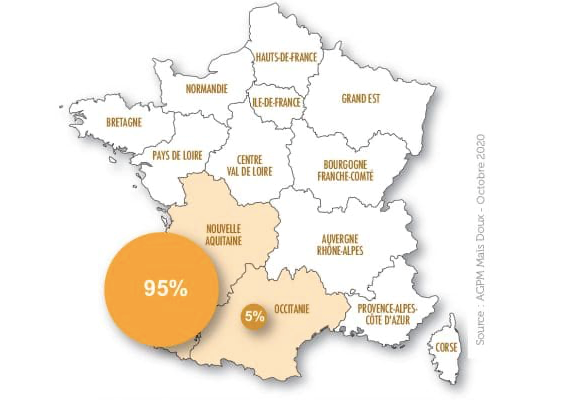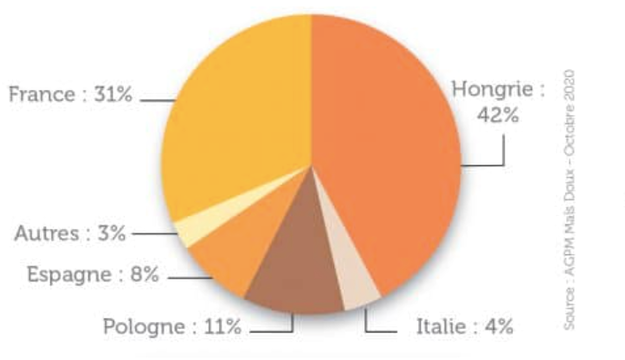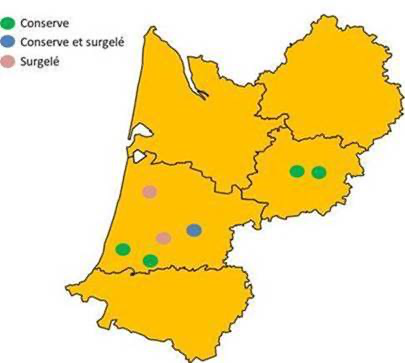Nicolas Montepagano, branch manager at A.G.P.M., is reporting on the current status of sweet corn cultivation in France. As the second producer of sweet corn for manufacturing and tied for first place in the production of canned corn, France is a European leader. However, the country’s consumption levels remain limited, with more than 80% of the production being exported. On the organic market, the production of sweet corn has strongly developed in recent years, but its consumption is now in decline, much like the entire sector.
History of the French production
The cultivation of corn goes back to ancient times, since it originated in South America and dates back to about 7,000 BC. The first written mention of sweet corn is much more recent, dating back to 1801. The popularity and consumption of sweet corn first developed in North America, especially in the USA from 1865 (and the Civil War) and even more from the 1930s. Sweet corn then developed in Europe from the 1970s, starting in France. The very first productions were in the center and southwest of the country, but the cultivation of sweet corn became really anchored in southwestern France with the construction of the first factory in the Landes in 1975. The French market really took off in the 1980s with the development of industrial tools, until the mid-1990s.
Today, the French production is mainly established in the southwest
The production of sweet corn for manufacturing (canned corn or frozen) is still mainly located in the southwest of France (94% in Nouvelle-Aquitaine and 6% in Occitania), mostly in the Landes, Gironde, Lot-et-Garonne, Pyrénées-Atlantiques, Gers departments, and to a lesser extent in the Dordogne, Pyrénées-Orientales, Tarn-et-Garonne and Charente-Maritime.
 Source: AGPM sweet corn
Source: AGPM sweet corn
The share of organic in the French production
The total surface area in 2021 is 22,120 ha, including 1,489 ha of organic production. The surface area of organic sweet corn has increased significantly since 2016, representing 6 to 7% of the French production plan since 2017.
France represents 31% of the European Union’s surface area
Within the European Union, France comes second in terms of sweet corn production for manufacturing, after Hungary and ahead of Poland, Spain and Italy. While Hungary has 45% of the EU surface areas, France accounts for 31%. The 750 farms that produce this corn are members of 5 producer groups in France.

Source: AGPM sweet corn
The sweet corn industry in France
The French production is processed by 7 factories located in France: 4 for canned corn, 2 for frozen corn and 1 where both canned and frozen corn are manufactured. Part of the production is processed in a factory located in Spain, but these volumes are very small. The industrial tools are located in the immediate vicinity of the production plots in order to guarantee that harvest and packaging are completed in the shortest possible time. Packaging is generally done in less than 6 hours after the harvest.

Canned corn represents 80% of the French production
The French production is mostly processed into canned goods. In total, for an average production of 180,000 tons of sweet corn in France (2019-2021 average), 80% of the production goes to the manufacturing of canned goods.
France is the leader in the production of canned sweet corn within the EU, together with Hungary. The production volumes of both countries are similar, with France representing 45% of the canned corn volumes of the EU and Hungary 37%, over the 2019-2021 period (source: AETMD: European Association of Sweet Corn Processors).
France: second largest producer of frozen sweet corn
France is the second largest producer of frozen sweet corn in the EU, after Hungary (in 2019-2021: France = 27% of the EU frozen sweet corn volumes and Hungary = 38%).
Besides this corn production for manufacturing, hundreds of hectares are dedicated to the fresh market, especially via short circuits, but this production remains quite limited in France.
Production cycle
The sweet corn is sown over a period of 3 months from early April until the beginning of July. The goal is to spread the harvests and allow enough time for the smooth operation of the industrial tools. The harvests take place from mid-July until mid-October. Sweet corn has the particularity of being harvested before reaching full maturity, after a production cycle of about 100 days.
French sweet corn mostly destined for the export market
The consumption of canned sweet corn in France remains limited, with less than 1kg per inhabitant per year. The average French person consumes about 600g of canned sweet corn per year (at home and outside of the home), which is the equivalent of a 4/4 can (850mL). This format does not really sell in France. The most popular formats are the ½ can (425mL) or ¼ can (212 mL).
Most of the sweet corn produced in France is exported
For the canned sweet corn, 82% of the French production is exported and 76% of the exports go to countries within the EU (mostly to the UK, Germany, Spain and Italy - in 2019-2021).
For the frozen sweet corn, 83% of the French production is exported and 76% of the exports go to EU countries (mostly to the UK, Belgium and Spain - in 2019-2021).
Highly positive trade balance
France’s trade balance was very positive, with a surplus of +137 million euros [146.8 million USD] in 2021.
The consumption of sweet corn in France is still limited and seasonal (source: Kantar-Unilet panel)
The consumption of sweet corn in France remains limited and very seasonal. 70% of the purchases are indeed made between April and September, with a very marked peak in July/August. Sweet corn is a vegetable whose consumption remains associated with nice weather, as it is mostly used as an ingredient in salads, although it can be enjoyed warm or cooked as well. Canned sweet corn accounts for most of the French consumption: 86% at home and 14% outside of home.
In 2021, the French consumed about 54 million 4/4 cans of sweet corn (net weight of 570g per can) for home or out-of-home consumption. However, these sales declined in 2021, in terms of both volumes (-11.7% compared to 2020) and value (-9.9% compared to 2020). This downward trend is also found on the market of canned vegetables, but the sweet corn shows a more significant drop in volume and value. However, it is important to be careful when comparing with the year 2020, which was marked by the Covid-19 pandemic and lockdowns that strongly impacted the consumption habits. Canned corn consumption was therefore expected to increase (+8.5% compared to 2019). 2021 should be compared to 2019 instead, a year that reflected more “normal” consumption trends. In 2021, canned sweet corn sales progressed compared to 2019, except from April to September (very sharp drop in July and August: -27% and -17% compared to 2019), as a result of the very rainy summer (fewer salads and picnics…)
Focus on organic consumption (source: Kantar-Unilet panel)
The consumption of organic corn in cans also decreased in 2021 (after having more than doubled in 2020 and being multiplied by 8 between 2016 and 2020). It represents nearly 9.8 million 4/4 cans in 2021, which is 18% of the home sales by volume. It had reached 21% of the total sweet corn home purchases in 2020. Nearly 20% of the French households consume canned organic corn (1.76 cans per year for an average annual budget of 3.92€ [4.20 USD].
Nutritional advantage of sweet corn
Sweet corn is low in calories (97 kcal per 100g), rich in fibers, minerals and vitamins of the B group, including vitamin B9 which is recommended for pregnant women. Easy to prepare, it causes no allergic reaction and is popular among children. It is therefore ideal to make them eat vegetables. It is also gluten-free and rich in water. All these elements can be found here.
For more information:
Nicolas Montepagano
Responsable filières
A.G.P.M.
21 Chemin de Pau
64121 Montardon
Phone: +33 (0)5 59 12 67 72
[email protected]
http://www.maizeurop.com/
